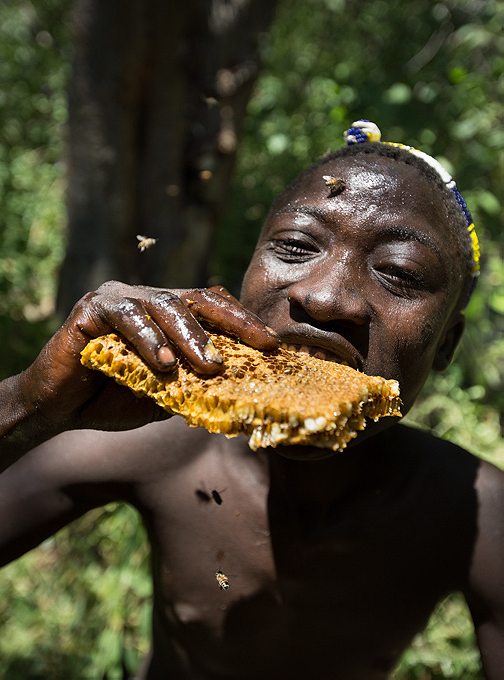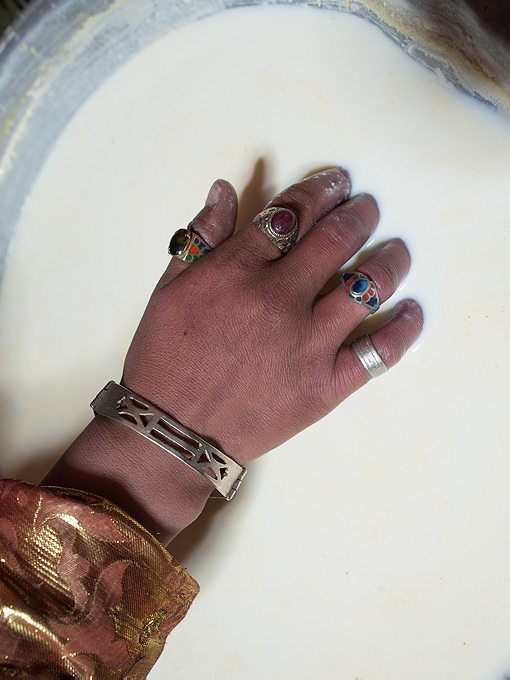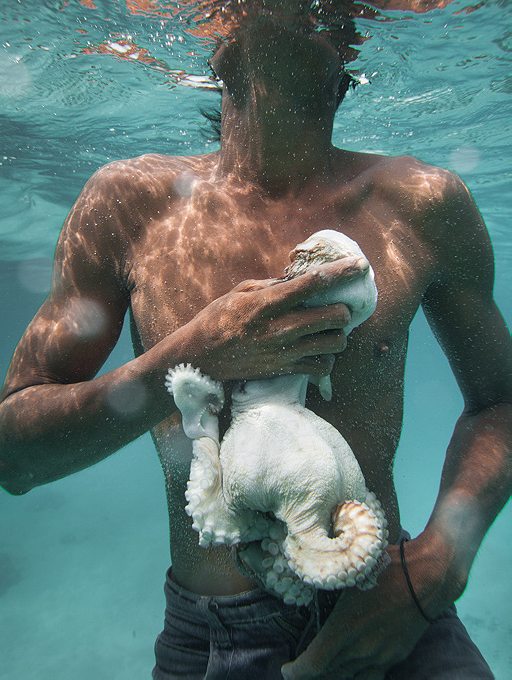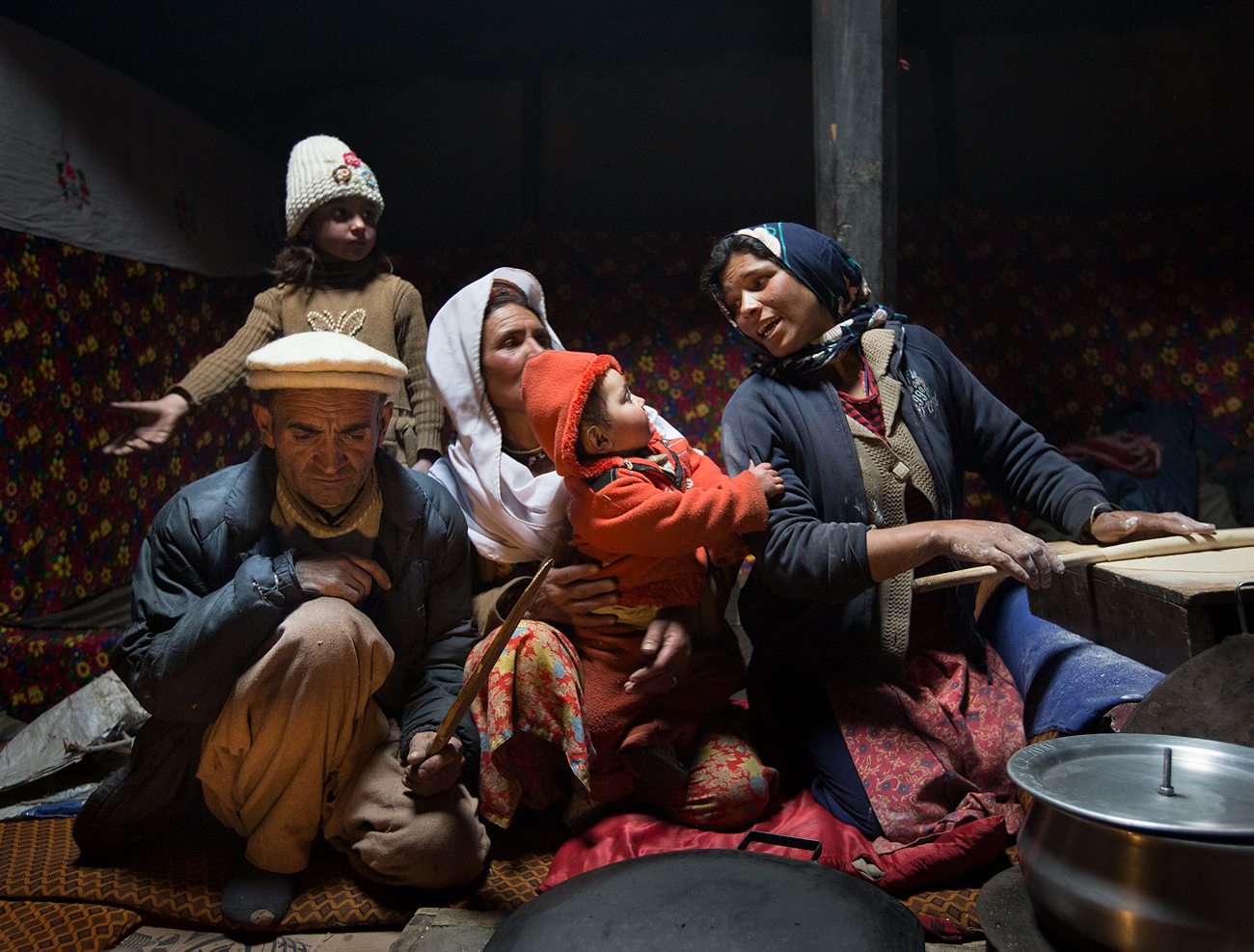The French photographer on his quest to document the food of our ancestors.
For the past few years, Matthieu Paley has been on a quest to photograph the food of our ancestors. He traveled to the Arctic, to the jungle, to the mountains and the desert, looking for the world’s oldest diets and what self-sufficient communities could teach the rest of the world. What he found was an incredible ability of the human body to adapt to nature in a harmonious way, but one that was also threatened by the culture of mass consumption even in the most remote of places. The French photographer is now raising funds to publish “Men & Food,” a book he is working on with the independent publishing house behind the beautiful culinary magazine 180°C. He joined R&K from his home in Turkey.
Roads & Kingdoms: Did everything start with the National Geographic project?
Matthieu Paley: Yes, absolutely. I have spent a lot of my career photographing the regions of Hindu Kush, Karakoram and Pamir, so west of the Himalayas, the north of Pakistan, the north-east of Afghanistan and Tajikistan. I’ve worked there for many years and still do today. As I was working on these documentary projects, especially when I was with a very remote Kirghiz community that lives in Afghanistan, I started looking at food. In self-sufficient communities such as these, everything revolves around acquiring food and eating it. So in photographing this community, I photographed what it takes to get food on the table. I did a story on them for National Geographic in 2011, and when they saw that I took a real interest in food, they asked me if I was interested in shooting a story for them on the Evolution of Diet, which looked at humans’ ancestral eating habits that are still practiced today. They asked me where I wanted to go, so there was a long preparation phase first. I looked at the world’s different environments–the Arctic, the jungle, the desert, the mountains–and from there, I selected places where communities lived self-sufficiently.

R&K: At what point did you realize you wanted to turn this assignment into a book?
Paley: You know, often photographers will work on one story and they’ll need someone else, an editor, to point out obvious things to them. I always work by instinct, finding things I’m passionate about, and it turns out there was a strong presence of food in my work. The team that makes a magazine called 180°C saw my work in Pamir and they contacted me about doing a food story in Pamir. I thought they were crazy. I was really surprised that a food magazine was interested in this, but I thought it was also very smart. We collaborated then, and again more recently on a story about Nauru. I became friends with the team and when I met them in Paris, they told me they wanted to start publishing books, and they wanted the first to be of my work. Of course, they’re independent so they would have to raise funds. I had other opportunities with publishers I’d worked with before, but I wanted to try and work with a small, motivated team whose work I really respected, so I said let’s do it.

R&K: Why is it important to document and to talk about ancestral culinary traditions?
Paley: First because these communities and their traditions are going to disappear soon. In the Arctic, for example, they’ve already made the transition. They still have a strong link with their ancestral culinary traditions, with the animals they eat and the way they hunt them, but I have not found one Inuit community that is self-sufficient. There are supermarkets in the most remote places. There was one place I went to by taking three planes and two helicopters. It’s so far that only 70 people live there, completely cut off from the rest of the world. But every few months, a huge boat comes to restock the supermarket, bringing industrialized and processed food. So the transition is already underway. They’ll eat seal with ketchup and mayonnaise. It’s a very interesting subject, that transition, but I was also looking for communities that were still self-sufficient to really understand how they do it and how we, as humans, have historically adapted to all types of environments in a healthy way. When you look at the Inuit, you might think the food they eat is really fatty but their traditional way of life, which includes hunting and all the physical efforts required to get food, mean that these people were very healthy and strong. Now there have problems with diabetes because they have an influx of market food.

R&K: There’s one sentence in the National Geographic article you worked on that says: “the foods we choose to eat in the coming decades will have dramatic ramifications for the planet.” Can you talk a bit about that?
Paley: There’s an expression in English that goes: this food is coated with oil, which means it’s traveled half the planet to arrive in a supermarket. It might be a sausage, but it’s full of petrol. We do insane things to eat today. It’s another reason why I’ve chosen to live where I live: I can pretty much live 100% on local foods. It’s a luxury, for sure, but it’s crucial that in the future people realize how important this is.
R&K: In all your travels, which community had the most impact on you?
Paley: Yes, the Hadza in Africa. These are people who live completely in the present. And in that sense, they are happy. They have no anxieties about how they’re going to eat the next day. The nature around them has provided food for their ancestors for the past 40,000 years–that’s how long scientists think they have lived there for. They hunt sustainably, because they hunt with bows and arrows unlike the Inuit who have switched to firearms. Sometimes they’ll spend a whole day hunting and won’t catch anything, and maybe once in a while they’ll get larger game. But to see that they don’t stock up on food, that every morning they wake up and there’s nothing to eat and that’s OK, was impressive to me. And they don’t grow anything. There’s a few communities throughout the world that we call hunter-gatherers, like the Tsimane in Bolivia, but the reality is that for the past 200 or 300 years, they’ve also been growing bananas or corn for example, just for security. The Hadza do not grow anything at all. They don’t have livestock. And they don’t stock up on food. If they find a bush that’s full of berries, they won’t collect them all in bags to take back to the village. They’ll just eat some there. This harmonious way to live with their environment makes them happy, from what I could tell.

R&K: Has this project changed the way you eat?
Paley: Not that much, but I did feel the need to know what it’s like to kill a sheep. It’s a bit weird to say but I felt like it was important for me to get my hands bloody if I wanted to eat an animal. In Tajikistan this September, they said they were going to kill a sheep and I said, “OK I’ll do it.” I would never have done this before, and I’ve seen many sheep get slaughtered while reporting in this region without being affected much. But when I did do it, having a knife in my hands and looking for the spot I would cut its throat, it was a powerful thing to me. I was always convinced that we shouldn’t eat too much meat, and killing a sheep reinforced that opinion. And then, I’m more sensitive to seasons. Here in Turkey when we know the tomatoes will stop coming, we’ll buy a bunch and make lots of sauces for example. I love that.

R&K: There are also all these new diets that many people in the West are obsessing over.
Paley: I’ve never been like that. There are many reasons to follow these kinds of diet. You might want to lose weight or you might want to do this for environmental reasons. But diet isn’t the only thing that’s important. All the people I’ve met who had to get out there and actually find food in nature, they were never unhealthy. They could walk hours in the jungle. So I think your way of life is even more important than your diet.
R&K: Are we so disconnected with nature that we’re trying to find new links with food?
Paley: We’ve definitely lost this primal link to food. People don’t know where the meat they buy comes from. It could be a new diet: if you want to eat meat, you have to kill it. Imagine how much the consumption of meat would decline. It might not be possible in New York apartments, but it’s a good idea. You know, I was watching the show Survivor in Turkey the other day because I have a friend who’s participating in it, and the prize for winning some of the challenges are a bottle of Coke or a hamburger. It’s deplorable. They should instead inspire the youth to eat healthy, but they completely miss it. It’s terrible. I hope that my book will be a small step in the other direction.